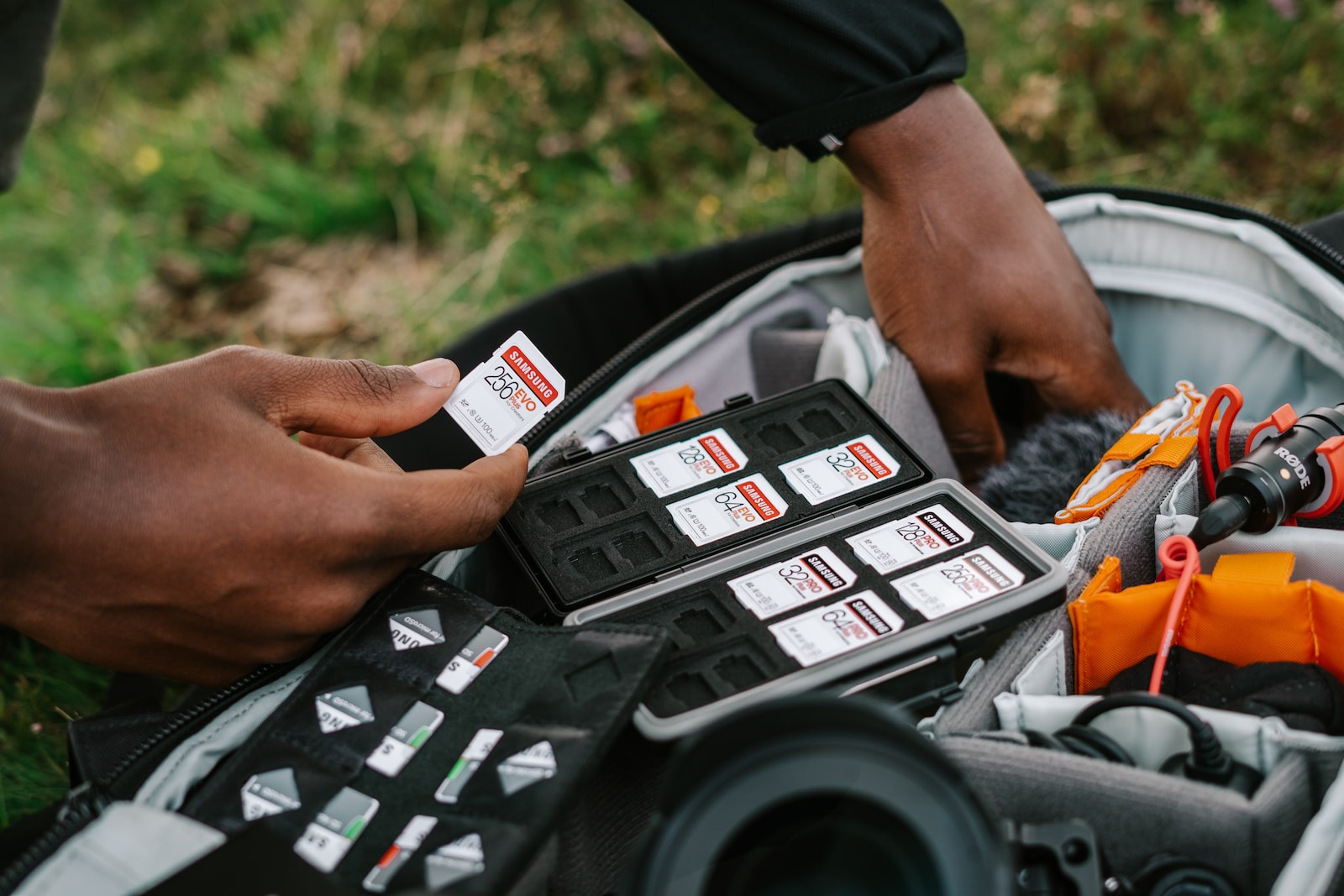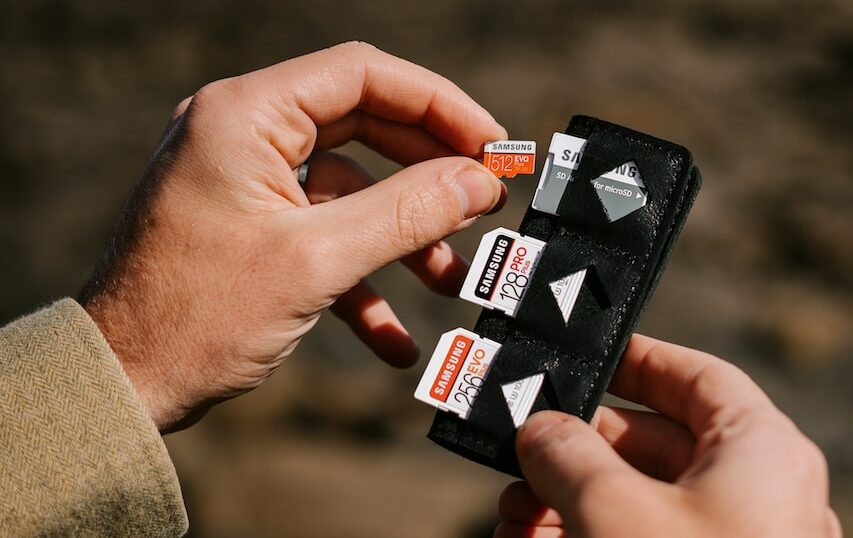Welcome to “Understanding SD Cards: A Comprehensive Guide.” If you’re a photographer or someone who relies on SD cards for data storage, you’ve come to the right place. In this blog, we will unravel the complex world of SD cards, explore their different classes, understand storage capacities, and uncover their durability. Whether you’re a beginner or an experienced user, join us as we dive deep into the fascinating realm of SD cards.
Table of Contents
What are SD Cards?
SD (Secure Digital) cards are small, portable storage devices used in digital cameras, smartphones, tablets, and other electronic devices. They fit conveniently into a device’s SD card slot, providing ample storage space for photos, videos, documents, and more.
Classes of SD Cards
SD cards are categorized into different classes, each serving a specific purpose. The class indicates the minimum sustained write speed of the card. Let’s explore the most common classes:
Class 2 and Class 4 SD Cards
Class 2 and Class 4 SD cards are entry-level options, boasting minimum write speeds of 2 MB/s and 4 MB/s, respectively. These cards are suitable for everyday use, such as capturing standard-quality photos and videos.
Class 6 and Class 10 SD Cards
If you require faster write speeds for shooting high-definition videos or capturing burst-mode photos, Class 6 and Class 10 SD cards are ideal choices. With minimum write speeds of 6 MB/s and 10 MB/s, respectively, these cards ensure smooth and reliable performance.
UHS Speed Class 1 (U1) and UHS Speed Class 3 (U3) SD Cards
For professional photographers and videographers working with 4K UHD videos or RAW image files, UHS Speed Class 1 (U1) and UHS Speed Class 3 (U3) SD cards are a must-have. U1 offers a minimum write speed of 10 MB/s, while U3 guarantees a minimum write speed of 30 MB/s.
Which SD Card Class Should You Buy?
Here is a table of all the types of classes for the SD card and their corresponding minimum write speeds and video formats:
| Class | Minimum write speed | Video format |
|---|---|---|
| C2 | 2 MB/s | Standard definition |
| C4 | 4 MB/s | High definition |
| C6 | 6 MB/s | High definition |
| C10 | 10 MB/s | Full HD |
| U1 | 10 MB/s | Full HD |
| U3 | 30 MB/s | 4K |
| V6 | 6 MB/s | Full HD |
| V10 | 10 MB/s | Full HD |
| V30 | 30 MB/s | 4K |
| V60 | 60 MB/s | 8K |
| V90 | 90 MB/s | 8K |
The class of the SD card determines the minimum sustained write speed that the card can achieve. This is important for recording video without dropping frames or losing quality. The higher the class, the faster the card and the higher the video resolution it can support. You should choose a class that matches your device’s specifications and the video quality you want to record.
Storage Capacities of SD Cards
SD cards come in various storage capacities, ranging from a few gigabytes (GB) to multiple terabytes (TB). The capacity you choose depends on your storage needs and the type of content you intend to store. As technology advances, SD cards continue to offer larger storage options, ensuring you have ample space for your expanding collection of photos and videos.
Durability and Longevity of SD Cards
SD cards are designed to be durable, allowing them to withstand various environmental conditions and everyday wear and tear. However, it’s essential to handle them with care to ensure their longevity. Avoid exposing them to extreme temperatures, moisture, and physical damage. Regularly backing up your data is also crucial to safeguard your precious memories.
Did you know that the largest SD card capacity commercially available is a whopping 1 TB?
Consider Your Device’s Compatibility
Before purchasing an SD card, ensure it is compatible with your device. Check your device’s manual or specifications for the supported SD card types and capacities.
Assess Your Storage Needs
Determine the amount of storage you require based on your shooting habits. If you frequently capture high-resolution photos or record lengthy videos, opting for a higher storage capacity is advisable.
Budget and Brand Considerations
SD cards vary in price based on their storage capacity, speed class, and brand. Set a budget and choose a reputable brand to ensure a reliable, quality product that meets your specific requirements.
Monitoring Card Health
Using software provided by your SD card manufacturer, periodically check the health and integrity of your cards. This will help you detect any potential issues and prevent data loss.
The Future of SD Cards
As technology progresses, SD cards continue to evolve. With advancements like faster transfer speeds, increased storage capacities, and enhanced durability, SD cards will continue to be a reliable storage solution for photographers, videographers, and technology enthusiasts alike.
Understanding SD cards, their classes, storage capacities, and durability is vital for making informed decisions about which SD card suits your needs best. Consider the speed class, storage capacity, and brand reputation when purchasing an SD card. With proper care, an SD card can accompany you on your photography journey, storing countless memories.
SD Cards Key Specifications
Here is a table for SD cards and the specifications with:
| Factor | Description |
|---|---|
| Card type | SD cards come in three main types: SD, SDHC, and SDXC. The type determines the maximum storage capacity and compatibility of the card. SD cards can store up to 2 GB, SDHC cards can store from 2 GB to 32 GB, and SDXC cards can store from 32 GB to 2 TB. You need to check your device’s specifications to see which type it supports. |
| Card size | SD cards also come in three physical sizes: standard, mini, and micro. Standard SD cards are the most common and measure 32 x 24 x 2.1 mm. Mini SD cards are smaller and measure 21.5 x 20 x 1.4 mm. Micro SD cards are the smallest and measure 15 x 11 x 1 mm. Some devices may require a specific size, while others may accept different sizes with adapters. |
| Speed class | SD cards have different speed classes that indicate the minimum write speed of the card. The speed class is marked by a number inside a circle or a letter inside a U or a V. The higher the number or letter, the faster the card. The speed classes are: Class 2 (2 MB/s), Class 4 (4 MB/s), Class 6 (6 MB/s), Class 10 (10 MB/s), U1 (10 MB/s), U3 (30 MB/s), V6 (6 MB/s), V10 (10 MB/s), V30 (30 MB/s), V60 (60 MB/s), and V90 (90 MB/s). You need to choose a speed class that matches your device’s requirements and the type of content you want to record or store. |
| Application performance class | SD cards also have an application performance class that indicates the random read and write performance of the card. This is important for running applications from the card, such as on smartphones or tablets. The application performance class is marked by a number next to an A. The higher the number, the better the performance. The application performance classes are: A1 (1500 IOPS read, 500 IOPS write) and A2 (4000 IOPS read, 2000 IOPS write). IOPS stands for input/output operations per second. You need to choose an application performance class that meets your device’s specifications and the type of applications you want to run. |
| Video speed class | SD cards also have a video speed class that indicates the minimum sustained write speed of the card for recording video. This is important for capturing high-resolution and high-frame-rate video, such as 4K or 8K. The video speed class is marked by a number next to a V. The higher the number, the faster the card. The video speed classes are: V6 (6 MB/s), V10 (10 MB/s), V30 (30 MB/s), V60 (60 MB/s), and V90 (90 MB/s). You need to choose a video speed class that matches your camera’s specifications and the video quality you want to record. |
I hope this table helps you to understand the different factors of SD cards and how to choose the right one for your use.
A Case Study: Choosing the Right SD Card for a Professional Photographer
When it comes to digital photography, the importance of choosing the right SD card cannot be overstated. As a professional photographer with several years of experience, I have had my fair share of challenges and lessons learned when it comes to SD cards. Let me share with you one of my most memorable experiences and how I overcame the challenges that came my way.
Choosing the Right Class and Storage Capacity
During one of my high-profile photoshoots, I made the mistake of underestimating the storage capacity I would require. I was shooting a wedding, and with the excitement of capturing every precious moment, I ran out of space on my SD card halfway through the event. It was a nightmare but a valuable lesson learned.
I realized that I needed a higher class SD card with a larger storage capacity. From that point on, I started using Class 10 SD cards with at least 64GB of storage for all my professional shoots. This ensured that I could capture thousands of high-resolution images without running out of storage space.
Ensuring Durability and Reliability
Another challenge I faced was the durability of SD cards. On one occasion, I accidentally dropped my camera, causing the SD card to become corrupted and all the images on it to be lost forever. It was devastating.
To prevent such mishaps in the future, I invested in SD cards that were shockproof and temperature resistant. These additional features provided me with peace of mind, knowing that my valuable photographs would remain intact even under challenging conditions.
Resolving Compatibility Issues
Lastly, I encountered compatibility issues with certain SD cards and my camera. Not all SD cards are compatible with all camera models, and this caused me significant frustration at times.
To overcome this challenge, I adopted the practice of purchasing SD cards specifically recommended by the camera manufacturer. This ensured seamless compatibility, faster read and write speeds, and ultimately enhanced the overall performance of my camera.
Through my case study, I hope you understand the importance of choosing the right SD card for your photography needs. Consider the class, storage capacity, durability, and compatibility with your camera before making a purchase. By learning from my challenges and adapting my strategies, I can now confidently say that my SD card woes are a thing of the past.
Frequently Asked Questions
1. What are SD cards?
SD cards, short for Secure Digital cards, are small and portable storage devices commonly used in electronic devices such as cameras, smartphones, and tablets. They are designed to provide additional storage capacity.
2. What are the different classes of SD cards?
SD cards are categorized into different classes based on their minimum sustained write speeds. The classes include Class 2, Class 4, Class 6, Class 10, UHS Speed Class 1 (U1), and UHS Speed Class 3 (U3). Each class represents a minimum writing speed, with higher classes offering faster data transfer rates.
3. How much storage capacity do SD cards have?
SD cards come with various storage capacities, ranging from a few gigabytes (GB) to several terabytes (TB). The most common storage capacities include 2GB, 4GB, 8GB, 16GB, 32GB, 64GB, 128GB, 256GB, and 512GB, catering to different storage requirements.
4. How durable are SD cards?
SD cards are designed to be durable and resistant to everyday wear and tear. They are shockproof, waterproof, and X-ray proof, ensuring the safety of your data even in challenging environments. However, it is essential to handle them with care and avoid exposing them to extreme temperatures or physical damage.
5. Can SD cards be used interchangeably among devices?
Generally, SD cards can be used interchangeably among devices that support them. However, compatibility may vary depending on factors such as device compatibility, SD card generation, and storage capacity. It is advisable to check the device specifications and consult the user manual for compatibility information.
6. Is it possible to recover data from a damaged SD card?
Yes, data recovery is possible from a damaged SD card. There are various data recovery software and services available that can help in retrieving lost or corrupted data from SD cards. However, it is recommended to regularly back up your data and avoid using damaged SD cards to prevent data loss.
Wrap Up
Understanding SD cards is crucial for every photographer’s success. By knowing the different classes of SD cards, you can make informed decisions about their storage capacities and durability. Whether you are a professional or an amateur, having the right SD card can significantly enhance your photography experience.
Remember, when selecting an SD card, always consider your specific needs and camera requirements. It’s essential to invest in a high-quality, reliable SD card that can handle the demands of your photography style. By doing so, you can ensure that your precious memories are safely stored and easily accessible.
We hope this comprehensive guide has shed light on the complex world of SD cards. If you have any questions or would like to share your experiences, please leave a comment below. We’d love to hear from you!



